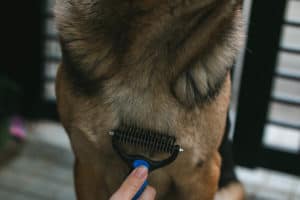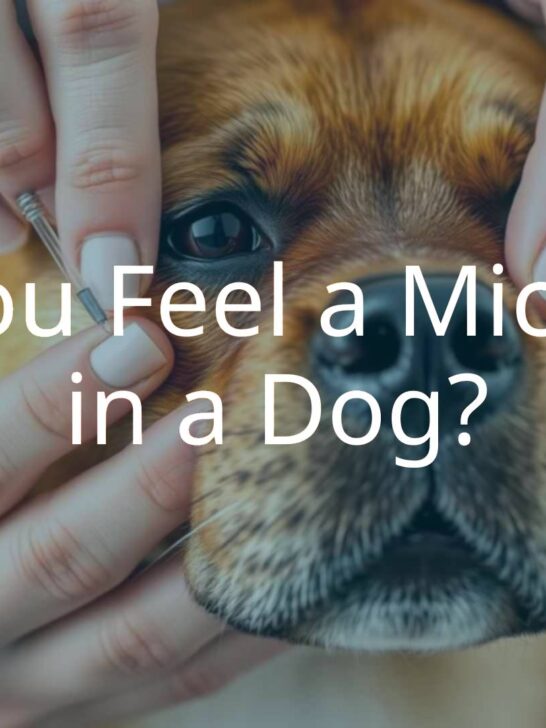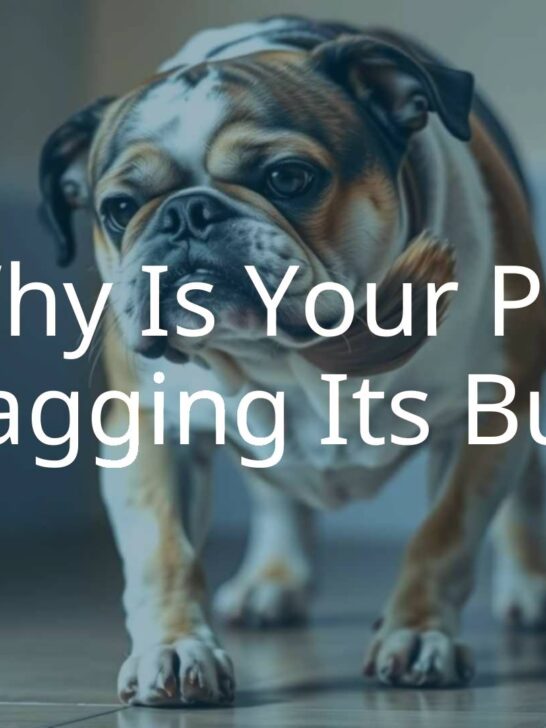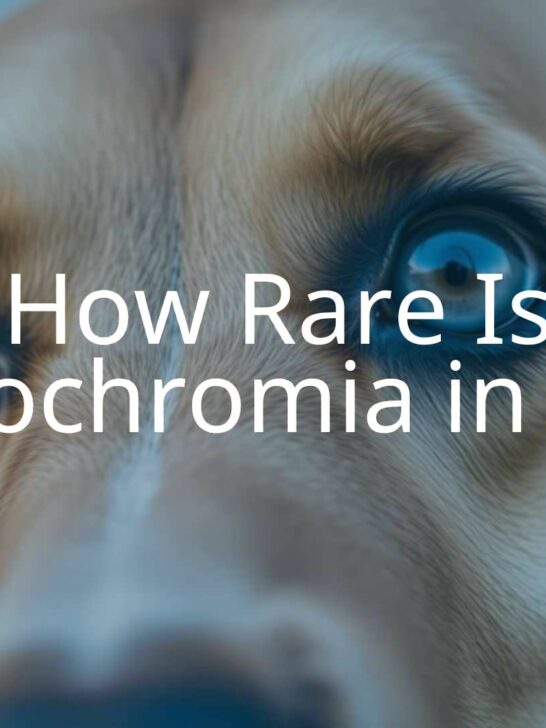Can You Feel a Microchip in a Dog?
A common question dog owners ask is, “Can you feel a microchip in a dog?” The short answer is usually no, not if it was put in the right way. Microchips are very small, about the size of a grain of rice, and are placed under your dog’s skin, usually between the shoulder blades. Their main job is to give your dog a permanent ID that connects them to you, which is very helpful if your dog ever gets lost. The procedure is fast and feels like a regular shot. Once in place, the microchip is meant to be something your dog never notices, quietly keeping them connected to you if needed.

Microchips are a simple and reliable way to help bring lost pets home. If your dog is lost and ends up at a shelter or vet, a quick scan of the microchip will show your contact information. Many places, such as England, Scotland, and Wales, require dogs to be microchipped by eight weeks of age, showing how important they are for safety and good pet care. So, while it’s natural to wonder if you can feel the chip under your dog’s fur, remember its main job is to stay hidden and safe, giving you peace of mind.
Can You Feel a Dog’s Microchip by Touch?
In most cases, you should not easily feel a microchip. When the chip is placed correctly, it settles into the tissue under the skin, making it hard to notice with your fingers. Its job is to work as a long-term form of ID without sticking out or bothering your dog at all. You can think of it as a secret ID card that only shows its information when scanned.
But, it doesn’t always work out perfectly. In some rare cases, owners may feel a small lump. This happens more in dogs with thin skin or those who are skinny since there is less tissue to cover the chip. If you do feel something, it should feel like a tiny, firm, rice-sized bump. If you can’t feel the chip, that’s a good sign that it’s inserted well and is doing its job properly.

What Does a Microchip Feel Like?
If you’re able to find the microchip by touch, it often feels like a small, hard, narrow bump with rounded ends-similar to a grain of rice. The typical spot is between your dog’s shoulder blades. Sometimes you can roll it gently under the skin. This bump is different from other lumps or bumps, which might be softer, oddly shaped, or sore.
Most of the time, the microchip isn’t noticeable-especially if your dog has thick fur or more body fat. This is because the chip is tiny and placed by someone trained to do it right. The procedure involves a needle like getting a vaccine, and after it’s in, the body puts a thin layer of tissue around it, making it even harder to feel and keeping it from bothering your pet.
Why Might a Microchip Be Easy or Hard to Feel?
How easy it is to feel a microchip depends mainly on your dog’s size, build, and skin type. Small dogs, thin breeds, or those with very short fur may have a chip that’s easier to feel because they have less tissue to cover it. This doesn’t mean the chip was placed wrong-just that there’s less to hide it.
Sometimes, a microchip moves from the spot where it was first put in. Although it’s supposed to stay in one place, microchips aren’t anchored, so they can shift to areas like the chest or even an armpit. This movement normally isn’t a big problem and doesn’t stop the chip from working. Vets know about this possibility and will scan the whole dog if they don’t find the chip in the usual place. So, the best way to confirm there’s a chip and that it still works is to have a vet scan your dog.
| Situation | Chance of Feeling the Microchip |
|---|---|
| Dog with thick fur | Not likely |
| Dog with thin skin/fur | More likely |
| Microchip moved | May feel it in new spot |
Are There Risks or Side Effects if You Can Feel a Microchip?
Finding a lump under your dog’s skin can be worrying. But if you suspect you are feeling a microchip or the area where it was put in, there’s usually little reason for concern. Millions of pets get microchips every year, and problems are very rare. The benefits of having a way to ID your pet for life are much more important than the tiny chance of a side effect.
The microchipping process is safe, quick, and usually feels like a regular shot. Most dogs don’t notice much. The chip is tiny and inactive, so it almost never causes lasting problems. Your peace of mind-knowing your lost pet could find their way home-makes a possible bump well worth it.
Is a Lump After Microchipping Normal?
Right after your dog gets a microchip, you might feel a tiny lump or some mild swelling where the chip went in. This is like what can happen after any vaccine or shot. This mild bump should go away in about a day. In some dogs, especially those that are thinner, the hard, rice-grain-sized chip can be felt under the skin. This is usually nothing unusual-just the chip itself.
If you keep feeling a lump weeks or months later, and it seems the size and shape of a grain of rice, it’s probably just the chip. Rarely, side effects can happen like minor bleeding, short-term hair loss, infection, or tissue forming around the chip. These issues are extremely uncommon, with study data showing a side effect rate as low as 0.0001%.
When Is a Palpable Microchip a Concern?
Most of the time, feeling a microchip is harmless. But if the lump is larger than a grain of rice, is soft, oddly shaped, sore, or seems painful to your dog, you should talk to your vet. Signs like pain, swelling, or your dog acting upset when you touch the spot could mean an infection or a reaction. In extremely rare cases, tumors have been found, though the link is weak and the risk is very low.
If the microchip has moved and you notice a lump in a new place, that’s normal, but a vet can check it with a scanner if you’re unsure. If you have any worries about a lump or your pet’s reaction, your vet should check it out to be sure everything is okay.
- Most common cause of a lump: Just the chip itself.
- Rare side effects: Minor swelling, redness, or infection.
- When to see a vet: Lump is large, painful, odd-shaped, or your dog seems distressed.
What If You Can’t Find the Microchip?
It’s common not to feel your dog’s microchip. In fact, for many dogs, the chip stays completely hidden-so if you don’t find anything when you pet your dog, that’s normal. Chips are made to be hard to notice by touch, hidden by your dog’s fur and the layers under the skin. The best way to check a microchip is to scan it, not to feel for it.
It’s a good idea to keep your dog’s microchip details up to date, even if you can’t feel it. August 15 is “Check the Chip Day” every year-a good reminder to make sure your contact info with the microchip company is correct. A microchip only works if your information is current.
How to Have a Microchip Checked
To know for sure if your dog’s microchip is present and working, have your vet or local shelter scan it. These places have handheld scanners that send a signal to the chip and read its special number. The process is fast, painless, and doesn’t bother your dog.
Usually, they’ll scan between your dog’s shoulder blades first. But since chips sometimes move, they’ll also scan the chest, sides, and legs. Once the scanner finds the chip and reads the number, that number can be checked in a database (like the AAHA database) to see which company it’s registered with and to pull up your contact info.
When Should You Call the Vet About a Microchip?
Not being able to feel a microchip under your dog’s skin is almost always okay. But if you just got your dog and don’t know if they have a chip, or if you find any new lumps or bumps, it’s smart to visit your vet. They can check for a chip and talk to you about putting one in if needed. This is especially important in areas where microchips are required by law.
You should also go to the vet if your dog was chipped a long time ago and hasn’t been checked lately, or if your contact information has changed. The vet can show you how to update your info so your pet’s chip always is linked to the right address and phone number.
| Situation | What to Do |
|---|---|
| Can’t feel chip, but no lump or problem | No action needed. Get chip scanned during vet visits. |
| Can’t feel chip, but worried about information | Check and update info with microchip registry. |
| Recent adoption, not sure if dog is chipped | Vet can scan for a chip and help register if needed. |
| Unusual lump, dog is acting different | See the vet for a checkup and scan. |
























